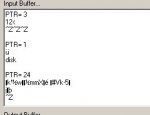References...
http://wiki.github.com/nseidle/OpenLog/command-set
http://wiki.github.com/nseidle/OpenLog/datasheet
I have an OpenLog device connected to a Picaxe28X2.
I am using Pins C.1 and C.2 . I have a 2GB uSD card installed.
I am trying to create a file name in the form yyymmdd.txt.
Seems from the data sheet all I need to do is send 3 character 26 (^Z)
It should reply with ‘>’ which indicates OpenLog is ready to receive commands. Then I should send "append yyyymmdd.txt" followed by ^Z to be logging to that file.
I know I have the TX & RX the right way around as it LED on the OpenLog flickers when data is sent to it, I have managed to right data to a default log file and I can see the initial string when it starts, which is "12<".
Command Mode
So far I have not been able to get it to respond to the escape sequence.
CONFIG.txt
Also I have not had any luck with the case sensitive file called CONFIG.txt on the uSD card.
I have created the file CONFIG.txt with 9600,26,3,1 as the contents.
That should start up OpenLog with 9600 baud, 26 as the escape char, required 3 times and the 1 indicates SeqLog mode.
SeqLog appends a file called "SeqLog.txt" at every power up and immediately starts logging.
Has anyone managed to have this work? Or had any luck with using the CONFIG.txt file to control and actions.
http://wiki.github.com/nseidle/OpenLog/command-set
http://wiki.github.com/nseidle/OpenLog/datasheet
I have an OpenLog device connected to a Picaxe28X2.
I am using Pins C.1 and C.2 . I have a 2GB uSD card installed.
I am trying to create a file name in the form yyymmdd.txt.
Seems from the data sheet all I need to do is send 3 character 26 (^Z)
It should reply with ‘>’ which indicates OpenLog is ready to receive commands. Then I should send "append yyyymmdd.txt" followed by ^Z to be logging to that file.
I know I have the TX & RX the right way around as it LED on the OpenLog flickers when data is sent to it, I have managed to right data to a default log file and I can see the initial string when it starts, which is "12<".
Command Mode
So far I have not been able to get it to respond to the escape sequence.
CONFIG.txt
Also I have not had any luck with the case sensitive file called CONFIG.txt on the uSD card.
I have created the file CONFIG.txt with 9600,26,3,1 as the contents.
That should start up OpenLog with 9600 baud, 26 as the escape char, required 3 times and the 1 indicates SeqLog mode.
SeqLog appends a file called "SeqLog.txt" at every power up and immediately starts logging.
Has anyone managed to have this work? Or had any luck with using the CONFIG.txt file to control and actions.

